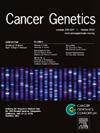46.临床 SNP 阵列为骨髓衰竭综合征的诊断和监测增添价值
IF 1.4
4区 医学
Q4 GENETICS & HEREDITY
引用次数: 0
摘要
细胞基因组 SNP 芯片(SNP-A)在骨髓衰竭综合征(BMFS)诊断和监测中的应用越来越广泛。了解这些异质性疾病的生物学特性是适当识别、解释和跟踪具有预后意义的克隆的必要条件,其中一些克隆可能代表体细胞基因挽救(SGR)事件。我们回顾了本机构检测的 100 多例 BMFS 病例的 SNP-A 结果。有 30 例报告结果异常,包括 9 例再生障碍性贫血(AA,30%)、11 例 Shwachman-Diamond 综合征(SDS,37%)、6 例 SAMD9/SAMD9L 相关综合征(20%)和 4 例钻石-贝克范贫血(DBA,13%)。在 15 个病例(50%)中,SNP-A 特征与 SGR 和获得性致病变体校正一致。在 12 个病例(40%)中观察到了含有致病基因的染色体的孤立 CN-LOH,其中包括两个 SDS(SBDS 基因)患者和三个 SAMD9/SAMD9L 相关综合征患者的 CN-LOH 7q,以及两个 RPS7 和 RPS19 相关 DBA 患者的 CN-LOH 2p 和 19q。与 SGR 相关的 CNV 包括同染色体 7q(SBDS)和 3 例 SDS 中的 20q 缺失(EIF6 基因)。在 4/30 例(13%)病例中观察到恶性转化 SNP-A,包括一例 SDS 病例中带有 TP53 第 1 层变异的 CN-LOH 17p,以及三例 SAMD9/SAMD9L 相关综合征病例中的 7 号单体。同时审查细胞遗传学/FISH、NGS 和/或种系 BMFS 结果(如果有的话);识别低水平、复杂和/或共存的克隆;以及为序列追踪进行准确的克隆估计是至关重要的,这也为临床管理增添了价值。我们的研究结果强调了 SNP-A 在 BMFS 诊断、预后和监测中的价值。本文章由计算机程序翻译,如有差异,请以英文原文为准。
46. Clinical SNP-array adds value to diagnosis and surveillance of bone marrow failure syndromes
Cytogenomic SNP microarray (SNP-A) utilization for diagnosis and monitoring of bone marrow failure syndromes (BMFS) is increasing. Understanding the biology of these heterogeneous diseases is required to appropriately identify, interpret, and track prognostically significant clones, some of which may represent revertant somatic genetic rescue (SGR) events. We reviewed SNP-A findings from our encounter of over 100 BMFS cases tested at our institution. Abnormal results were reported in 30 cases, including nine aplastic anemia (AA, 30%), eleven Shwachman-Diamond syndrome (SDS, 37%), six SAMD9/SAMD9L-related syndrome (20%), and four Diamond-Blackfan anemia (DBA, 13%) cases. In 15 (50%) cases, the SNP-A profile was consistent with SGR and acquired correction of the disease-causing variant. Isolated CN-LOH of the chromosome containing the disease-causing gene was observed in 12 (40%) cases, including CN-LOH 7q in two individuals with SDS (SBDS gene) and three individuals with SAMD9/SAMD9L-associated syndromes, and CN-LOH 2p and 19q in two individuals with RPS7 and RPS19-associated DBA, respectively. SGR-associated CNVs included isochromosome 7q (SBDS) and 20q deletion (EIF6 gene) in three cases of SDS. Malignant transformation SNP-A findings were observed in 4/30 (13%) cases, including CN-LOH 17p with TP53 Tier 1 variant in an SDS case and monosomy 7 in three cases of SAMD9/SAMD9L-related syndromes. Concurrent review of cytogenetic/FISH, NGS, and/or germline BMFS results, where available; identification of low-level, complex and/or coexisting clones; and accurate clonal estimation for sequential tracking are essential, and add value to clinical management. Our results emphasize the value of SNP-A in the diagnosis, prognosis, and monitoring of BMFS.
求助全文
通过发布文献求助,成功后即可免费获取论文全文。
去求助
来源期刊

Cancer Genetics
ONCOLOGY-GENETICS & HEREDITY
CiteScore
3.20
自引率
5.30%
发文量
167
审稿时长
27 days
期刊介绍:
The aim of Cancer Genetics is to publish high quality scientific papers on the cellular, genetic and molecular aspects of cancer, including cancer predisposition and clinical diagnostic applications. Specific areas of interest include descriptions of new chromosomal, molecular or epigenetic alterations in benign and malignant diseases; novel laboratory approaches for identification and characterization of chromosomal rearrangements or genomic alterations in cancer cells; correlation of genetic changes with pathology and clinical presentation; and the molecular genetics of cancer predisposition. To reach a basic science and clinical multidisciplinary audience, we welcome original full-length articles, reviews, meeting summaries, brief reports, and letters to the editor.
 求助内容:
求助内容: 应助结果提醒方式:
应助结果提醒方式:


